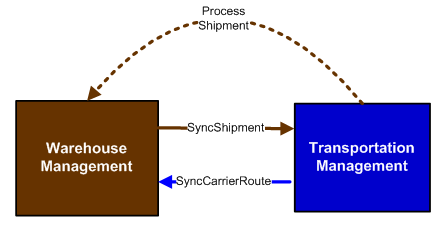Understanding the TM role within Infor Supply Chain Execution
The diagram illustrates the data flows between Infor SCE Transportation Management and Infor SCE Warehouse Management and describes the business document exchange for outbound goods processing. It refers to the activities required to handle shipments of product out of a warehouse. WM and TM are integrated either through Infor ION or a direct integration
See the Infor SCE Transportation Management Data Flows Guide for specific use cases and data flows.

- syncShipment: TM is notified of shipments by WM through a syncShipment BOD. WM is the system of record for the shipment, so any time any data regarding the shipment is modified, WM publishes a syncShipment to notify others who are interested in the shipment. The receipt of the syncShipment drives processing within TM. If any shipment data that TM is interested in changes as a result of a syncShipment, TM processes the data accordingly. If multiple syncShipments for the same shipment are received in the same batch, TM only consumes the most recent copy.
- syncCarrierRoute: TM publishes a syncCarrierRoute BOD that represents the carrier route resulting from processing within TM. TM is the system of record for the carrier route, so any time any data regarding the carrier route is modified, TM publishes a syncCarrierRoute to notify others who are interested in the carrier route.
- processShipment: TM publishes a processShipment to update certain transportation-related data on the shipment. A processShipment is published only if something has changed on the shipment. WM receives the processShipment, updates the shipment accordingly, and produces a syncShipment in response with the updated information since WM is the system of record for the shipment. Once a shipment order is in Loaded or Shipped status in WM, processShipment messages are not accepted.